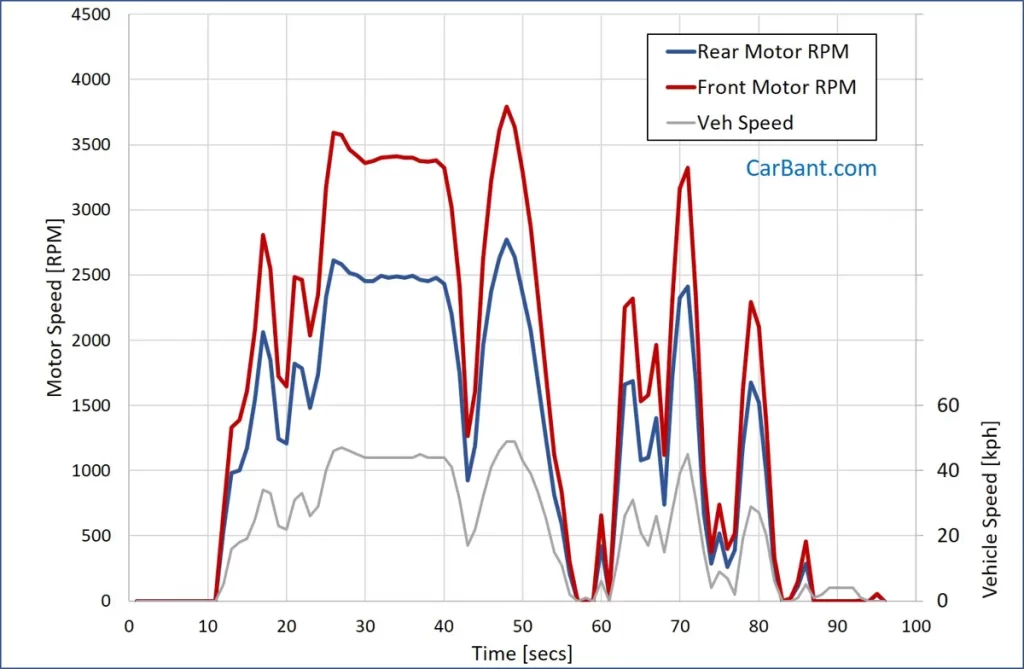Proper mechanical limited slip diffs are more expensive than the electronic alternative, so they are very very rarely OEM factory options on modern cars! I have searched extensively for a hybrid car fitted with a limited slip differential and almost all of them have an electronic LSD. Having said that, Lexus offer the LC500h with a limited slip differential.
Table of Contents
What is a Differential?
So, you know how a car has two wheels on each axle, right? Well, there’s this super important thingamajig called a differential that sits in between those wheels. Its job is to make sure that each wheel can rotate at different speeds. Plus, it helps distribute the engine or electric motor’s power evenly to both wheels, so you can go zooming down the road without burning through your tires too quickly.
In electric car’s and hybrids the diff also serves as a gear ratio to allow optimal torque and rotational speed for the electric motor paired with it.
There are all sorts of different types of differentials, from the simple and cheap open ones to the more fancy limited-slip and locking ones that give you extra grip in tricky driving conditions. Long story short, the differential is the unsung hero of your car’s drivetrain, and it’s what helps keep you rolling smoothly and safely down the road.
What is an Open Differential?
An open differential is the most basic type of differential found in many standard vehicles. It allows the wheels on the same axle to rotate at different speeds, which can be useful for turning and cornering. Check out the simple video below demonstrating why the wheels on the outside of the corner go further and faster than the inside wheels.
The way it works is that power from the engine is sent to a ring gear in the center of the differential, which is then split between the two axles. When a vehicle is moving in a straight line, the open differential allows both wheels on the same axle to rotate at the same speed, which helps maximize traction and efficiency.
However, when a vehicle is turning, the inside wheel needs to travel a shorter distance than the outside wheel. This means that the inside wheel needs to rotate more slowly than the outside wheel, in order to avoid skidding or sliding. An open differential allows this speed difference to occur, which can be beneficial for turning and manoeuvring, but it can also cause a loss of traction and control on slippery or uneven surfaces. This is because the wheel with less traction will receive more power, while the wheel with more traction will receive less power.
Overall, an open differential is a simple and effective design that is used in many standard vehicles. However, it can be limited in its ability to provide optimal traction and control in certain driving conditions, which is why other types of differentials, such as limited slip differentials and locking differentials, have been developed to help address these limitations.
Does a Hybrid Car Need a Differential?
In almost all cases, hybrids only have one motor per axle, so a differential is required. As a rule of thumb, if one motor is used to power 2 wheels, a differential is essential. If 2 motors are used to power individual wheels on the axle, a differential is not required.

My Mitsubishi Outlander PHEV is 4×4 wheel drive. The rear axle is powered solely by an electric motor. Not only is the diff used to power both wheels on the rear axle, it also performs another vital function. It acts as a gear ratio to suitably match the torque and speed requirements of the vehicle and motor.
Essentially, the final drive is baked into the differential, check out this OBD log I made, using my car to show how the gearing of the differentials is different from the front to the rear axle:

Fancy getting into your hybrid car’s data? Purchase a high quality OBD data logger from Amazon:

Why Limited Slip Differentials Are Superior
An open differential is like having two different skates on your feet – they can spin independently of each other, but they don’t work together very well. This can lead to all sorts of problems, like wheel spin, loss of traction, and uneven wear and tear on your tires. Enter the limited slip diff, otherwise known as an “LSD”. Limited slip diffs operate like an open diff under normal driving, but when you push your car to the limit, they use all sorts of fancy clutch plates and gears to make sure that power is distributed evenly to both wheels.
I am so convinced of their superiority over an open diff, I had to fit one to my MX5!

Limited slip diffs are not just for race cars and off-roaders – you can find limited slip diffs in all sorts of vehicles these days, from trucks and SUVs to MX5s and high powered hot hatches. So, if you want to take your driving to the next level and get better performance and stability out of your car, a limited slip diff is definitely worth considering!

Mechanical vs Electronic Limited Slip Differential
A mechanical limited slip diff is what you might call a “traditional” LSD. It uses physical mechanisms like clutch plates, gears, or cones to transfer power between the wheels. Conversely an electronic LSD uses a cheap open diff in conjunction with an advanced traction control strategy by actually braking individual wheels to limit or stop wheel spin.
In some circumstances an electronic diff might be preferable, not only is it cheaper (most of the hardware, sensors etc. are already fitted to the car for ABS and TCS function) software gives much greater range of flexibility and tunability at the touch of a button.
Mechanical diffs are preferable in some respects as they don’t rob the engine’s power by braking wheels, they simply send power to the wheel that has the most traction. In a race application you need to avoid excessive heat in the brakes or using engine power to heat up the brakes (rather than move the car) which is why racing cars including the Toyota TS050 Hybrid LeMans, employ a mechanical LSD.
How Does An Electronic LSD Work?
An electronic limited slip differential (eLSD) works by using a combination of sensors in union with the car’s brake systems to monitor and adjust the power distribution between the wheels on the same axle, in order to maximise traction and control in a variety of driving conditions.
The sensors used in an eLSD typically include;
- Wheel speed sensors, which monitor the rotational speed of each wheel,
- Steering angle sensor to measure the driver’s intended course
- Lateral acceleration sensors (g meters!), which measure precisely the cornering speed of the vehicle.
- Accelerator pedal position, to determine the driver’s torque request
These sensors send data to a control unit, which uses this information to determine the optimal amount of power to send to each wheel. Imagine a driver turning the steering wheel by a certain amount of degrees, the computer (most likely a stability control computer) would be able to calculate the theoretical turning speed and then use the lateral g sensors to measure and verify the actual turning speed.
Clearly if theory and reality deviate, the likelihood is the car is sliding (tyres skidding). Individual wheel speed sensors are also constantly measuring the speed of both wheels on the axle and feeding this to the stability control module
In order to adjust the power distribution, an eLSD uses a brake-based system. When the control unit detects that one wheel is spinning faster than the other, it will apply the brake on that wheel to slow it down and transfer more power to the other wheel. This helps to prevent the wheel with less traction from spinning freely, which can lead to a loss of control and stability.
What Hybrids Have a Mechanical Limited Slip Diff
Here’s a list of a slim bunch of options I can think of right now in 2023. I imagine things are set to change very soon, once hybrid car’s become cool and not just the reserve of taxi drivers and eco warriors!
- Lexus LC500h
- Subaru Crosstrek
- Honda CRZ
- BMW i8
- Toyota TS050
Many other vehicles you might see fitted with an LSD use the electronic type.
Before You Go…
Check out these other posts I have written that you are bound to find informative and interesting:

